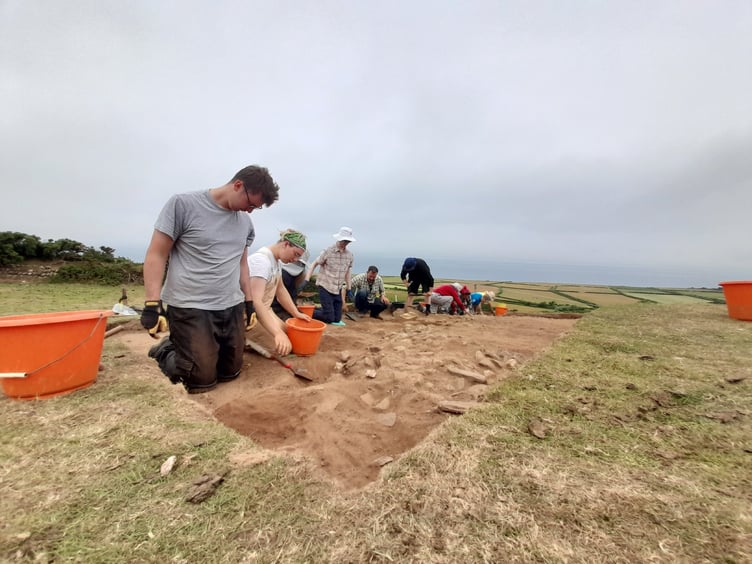On their fourth trip over to the island since 2017, a team of archaeologists made some fascinating discoveries that shed a light on the history of the Isle of Man.
The team had been unable to come and excavate the site up in the hills above Kirk Michael since 2019 as a result of the pandemic.
The team included 21 archaeologists; including students from the Universities of Leicester and Newcastle and a range of local volunteers.
They came to excavate a cist, which is a neolithic or Bronze Age burial chamber typically lined with stone.
Led by Dr Rachel Crellin and Professor Chris Fowler, the team worked in collaboration with Manx National Heritage who, alongside the universities, helped to fund the dig.
I spoke to Rachel about the discoveries made, and what the team hope to learn from them.
She is an associate professor of archaeology at the University of Leicester’s School of Archaeology and Ancient History, and was born and raised here on the island.
She said: ‘This season we found five new burials, which was particularly exciting.
‘So we excavated a cist that contained a cremation, and we found not one, not two, but three urns - upside down ceramic vessels that contained cremations - and another pit dug into the mound with the final cremations in.
‘All of those burials were clustered very tightly together in one area of the mound, which is quite interesting too, that they were all concentrated in the same area.
‘As well as that, we found lots of ceramics and the usual collection of flint.
‘A particularly beautiful arrowhead came out too. A kind of arrowhead that is from the early Bronze Age.
‘The other really exciting thing for us is that as we got underneath the mound, it became clear that there are features from before the site was used as a burial site.
‘We increasingly think that there’s evidence of a late neolithic settlement underneath the burial mound, so that’s really exciting for us. We set out to excavate a burial site, but it seems like we’ve got both a burial site and a settlement site in the same place.’
Regarding the discovery of remains, she added: ‘At the minute, we don’t know how far apart in time those five burials were.
‘It’s possible they could be over not that many years, in which case, are these people that perhaps knew each other?
‘Once we have the radiocarbon dates back we can think more critically about it.
‘Are these people who would’ve been known to each other and are from the same community or even the same family or kinship group?
‘That’s something that once we have the funding in place and can get all the data sorted, it will be a really interesting question for us to think about.
‘Are they buried together literally because they knew each other, or do those burials in fact span four, five hundred years, and they didn’t know each other, but they’re just going back to that same place?’
So, where does the team go from here, given the huge discoveries made?
‘For us, it leads into the scientific analysis that comes afterwards,’ she said. ‘So getting all of the specialist work done on those things, and that’s going to be our focus for the next two or three years.
‘We’ll get specialists to work on everything that we’ve found, we’ll have a really extensive set of radiocarbon dating, and we’ll use all of that to write a really detailed story of the mound that we’ll turn into a book, and that we’re also hoping to use as the basis to write a kid’s book about it as well.
‘We want to write something for school children on the Isle of Man that explains about the archaeology and the past of the island and explains a bit of what archaeologists do as well.
‘Over the course of the dig we worked with hundreds and hundreds of schoolchildren going and doing hands-on archaeology, which is really great, but we’re also really keen to try and turn that into a more lasting output and the book would allow us to do that.’
The latest excavation was part of an ongoing project, launched in late 2016, to investigate the Isle of Man’s prehistoric burial mounds (earthen mounds built over human burial sites).
The Isle of Man is home to more than 160 round mounds but very few have been excavated using techniques that have left a detailed and reliable record.
Round mounds were built sporadically during the Neolithic and in large numbers during the Early Bronze Age.
This project is investigating what these sites and their associated burials and artefacts can tell us about life on the Isle of Man during these periods, but also about interaction with other communities across Britain, Ireland and potentially beyond, in the Neolithic and Bronze Age.
The team will work with the Manx Museum for the foreseeable future, and it is hoped that all the finds will eventually go on display there.
‘Some of the material we might temporarily take away to get specialist analysis using equipment that we don’t have on the Isle of Man’, Rachel explains.
‘But a lot of what is going to be done will be carried out at the Manx Museum working with them.’
After 14 weeks of excavation over four seasons, the site is now buried again.
The team left around 5% unexcavated for posterity.
At the dig’s conclusion, Rachel tweeted saying: ‘It has been an absolute privilege to dwell on the side of a hill near Kirk Michael learning about the lives of people who did the same 4000 years ago.’
And as for the future?
Rachel said: ‘As somebody from the Isle of Man, who loves the Isle of Man and its archaeology, there are always other places that I want to dig, but I’ve not got any immediate plans!’
l The team thanked Manx National Heritage, with which the project was developed and primarily funded.
l It also received financial support from Culture Vannin, the University of Leicester and the University of Newcastle.
l The Steam Packet Company also supported this visit by assisting with travel costs for the archaeologists and their vehicles and equipment.
l And Glen Wyllin campsite was ‘the perfect home from home’ whilst they were here.





Comments
This article has no comments yet. Be the first to leave a comment.